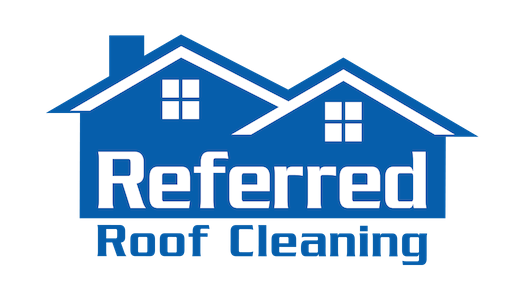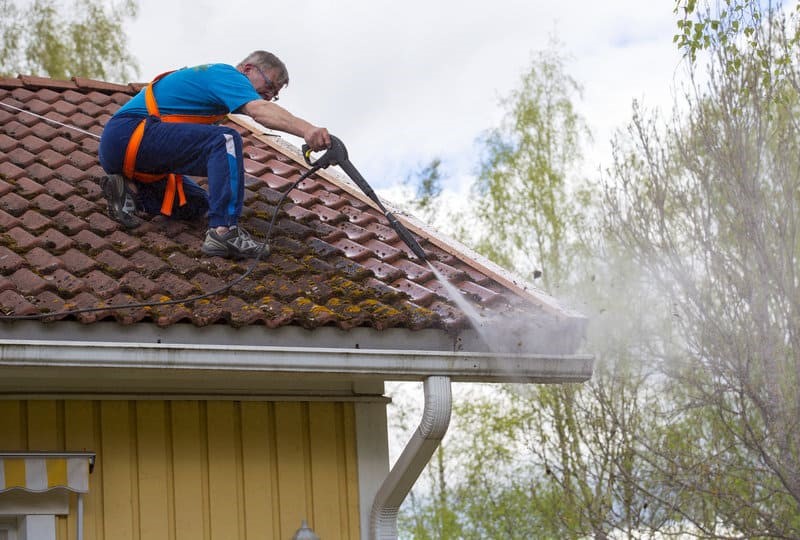Having moss on roofs is a problem that many homeowners deal with almost daily. This problem becomes more common in regions with a higher degree of humidity and rainfall. In the beginning, moss does not look that harmful, but if left unattended can lead to significant damage to the roof. If nothing is done to stop the growth of moss, it can cause severe damage like water leakages, shingles getting destroyed, and even result in structural problems. Moss treatment for roofs is essential to prevent these issues. Keeping your roof clean from moss is important to ensure it lasts longer and stays in great condition. Regular moss treatment for roofs can help protect your home from costly repairs and extend the lifespan of your roof.
In the following paragraphs, we will go over the comparison of manual and chemical removal. Both options serve unique purposes, but the focus here is which one is the optimal one for you. You will learn the pros and cons of manual and chemical moss treatment for roofs and choose which is best for you. Whether short benefits or a permanent solution are desired, we hope you will identify which option best suits your roof. Choosing the right moss treatment for roofs can proof that your home remains safe, secure, and free from any damages that moss can cause.
What Is Chemical Moss Treatment?
Chemical treatment for moss treatment for roofs involves the application of either biodegradable or chemical products with the aim of killing moss and stopping it from coming back. The techniques used for these chemical treatments work by dehydrating the moss for it to die off. The ingredients in these solutions not only work towards getting rid of moss but also taking care of them for a long duration of time, providing the best moss treatment for roofs that prevent future growth and damages.
The chemical moss treatment for roofs is done with the aid of sprayers or pressure washers that guarantee that the affected areas are thoroughly covered. These approaches are very beneficial for homeowners who want an enduring solution for moss because they not only solve the problem, they reduce unneeded maintenance work too. Also, the chemical moss treatments for roofs with roof moss killers that people use for these treatments have a life of several months.

What Is Manual Moss Removal?
The physical method involved in moss treatment for roofs is the use of tools like brushes, scrapers and pressure washers to actively and manually eliminate moss from your roof. This method consumes a lot of effort, however it is very effective in terms of speed and might be best suited for people who need immediate results. Strategies such as hand scraping and brushing moss off the roof are widely adopted to get rid of the invasive species so the roof ends up looking tidy.
Short-term manual removal works, but one must be extra careful because it can damage the roof shingles. If not handled correctly, there is a possibility of scratching, lifting, or breaking the shingles which will later lead to expensive repairs. Although there is a risk of damage, it does remain a common option for roof maintenance for people who want to avoid using chemicals for moss treatment for roofs.

Comparison: Chemical vs. Manual Moss Removal
When choosing between chemical moss treatments for roofs or manually scraping it off, one crucial aspect that needs consideration is roof safety, effectiveness, cost, and time. Let’s tackle the comparative analysis of moss removal methods to help settle on a single method for moss treatment for roofs.
Effectiveness
- Chemical Treatment: Moss treatment for roofs that use chemicals to treat moss for roofs work by killing existing moss and inhibiting its future growth. After application, chemical treatments take time to render the long-term effect of inhibiting moss growth.
- Manual Removal: Manual techniques such as scraping or brushing moss off the roof get rid of moss at once and thus provide instantaneous results. Unfortunately, it does not provide any long-term solutions, and moss is likely to grow back over time.
Time Required
- Chemical Treatment: Chemical treatments require a moss to die period of time, typically a few weeks, before it disappears.
- Manual Removal: Removal of moss is immediate since it is done manually, so it is noticeable right after it is performed.
Roof Safety
- Chemical Treatment: Chemical moss treatment for roofs is most often harmless for the roof and shingles, which have suffered no damage due to the treatment.
- Manual Removal: The downside of manual methods is they can risk damaging the shingles if the work involves aggressive scraping and pressure washing.
Cost
- Chemical Treatment: The chemical approach to moss treatment for roofs is often more expensive because of the necessary chemicals and specialized tools needed.
- Manual Removal: If carried out by yourself, manual removal can be cheaper, but for an expert, the labor cost is significant for this task.
Pros and Cons of Chemical Moss Treatment:

Pros:
- Prevents Regrowth: moss treatment for roofs not only eradicates moss but also stops its regrowth which is beneficial in the long-term.
- Less Labor-Intensive: After application, the chemical treatments will do most of the work, which saves a lot of time and work compared to manual methods.
Cons:
- Takes time to see results: For a few weeks, there will be no effect visible on the surface, the goal is achieved but the timeframe may not work for those wanting an instant solution. This is a key consideration when choosing moss treatment for roofs.
- May Harm Plants: Some plants can be damaged by certain chemicals, so precautions must be taken in order to protect the garden and lawn while applying the chemicals during moss treatment for roofs.
Pros and Cons of Manual Moss Removal:
Pros:
- Immediate Moss removal: With manual moss removal, you get immediate results and can remove the moss from the roof instantly, meaningful for the house’s lifespan.
- No chemical required: Unlike any chemical methods, an automatic way does not need any chemicals which is perfect for anyone wanting to avoid these processes when treating moss on roofs.
Cons:
- Risk of Shingle damage: There is a potential consideration that comes with manually removing moss where shingles are damaged. If you are too rough in scraping, or too aggressive with tools, you can easily ruin shingles by cracking them or pulling them out.
- Labor-intensive: Removing fountains manually is hard work and gruesome, and much more difficult if a roof has a larger colony of moss. Due to the nature of the work involved, it will take a very long time, along harder than using certain chemicals for moss treatment for roofs.
Which Moss Removal Method Should You Choose?
Try to identify what you want of the removal of moss, if it is immediate or long-term, before deciding. If you want a more permanent solution, check out the chemicals as they do a far better job with not only eliminating the current moss but also preventing future growth, leaving a lot of protection for the user with little work needed after that. Moss treatment for roofs using chemicals is highly effective in ensuring that moss does not return, providing peace of mind for homeowners in the long run.
For immediate needs, the manual method is efficient and effective when it comes to moss removal. Although it’s simple to implement, it needs to be performed with care to not damage your roof shingles. For best results, combine the two methods—begin with manual removal for an immediate solution, then follow with chemical treatment for roofs to restrict moss growth.
For more tips regarding roof cleaning, consult the professionals prior to the implementation of any particular technique to ensure your roof does not receive unnecessary damage.
Conclusion
In conclusion, both moss treatment for roofs methods have their advantages when it comes to roofs covered with moss. Chemical treatments work best for long-term prevention as they kill the existing moss and block new moss from growing, although they take longer to yield results. In contrast, manual removal can be performed anytime and is immediately effective, but can result in damage to your roof if not done carefully.
Think over what is most important to you when deciding the best method of moss treatment for roofs. If long-lasting protection is what you are after, use chemical treatments. If speed is what you need, use manual removal, but be prepared to perform regular maintenance or treatment to prevent moss growth.
Seeking professional assistance is advisable when using chemical treatments due to the potential risks involved. Professionals are able to provide the correct application that will not jeopardize your roof or landscaping.
DIY solutions can create more problems than they solve; it is not worth risking damage to your roof. Allow us to help you with a risk-free consultation. Maintain the condition of your roof with Referred Roof Cleaning, the best choice for roof maintenance. Contact us now for help with moss treatment for roofs.
FAQ
- What is the best moss treatment for roofs?
Chemical treatment works best when it comes to prevention; on the contrary, manual removal is effective immediately.
- Can I remove moss from my roof myself?
Yes, you can remove moss manually using the manual moss removal method, but it can be labour-intensive and may risk damaging shingles. It’s often good to hire professionals.
- Is chemical moss treatment harmful to plants around my house?
Some chemical moss trreatments may harm nearby plants. So make sure to protect your garden during chemical moss treatment for roofs to avoid risks and damage.
- How long does chemical moss treatment take to work?
Chemical moss treatments can take a few weeks to show visible results, making them ideal for long-term prevention but not quick fixes.
- How can I prevent moss from growing back on my roof?
To prevent moss regrowth, combine moss treatment for roofs with regular maintenance and ensure proper roof drainage.


Recent Comments